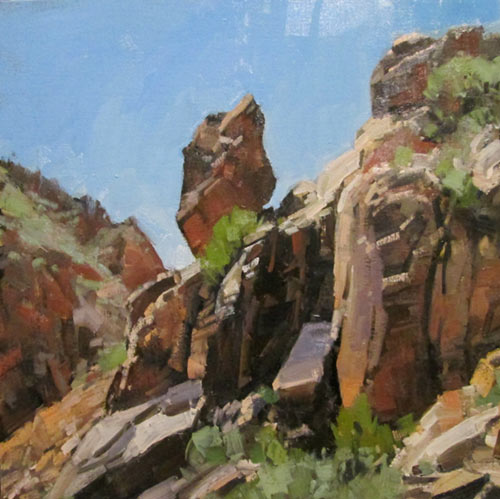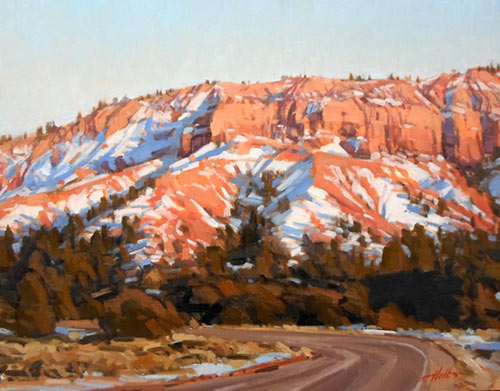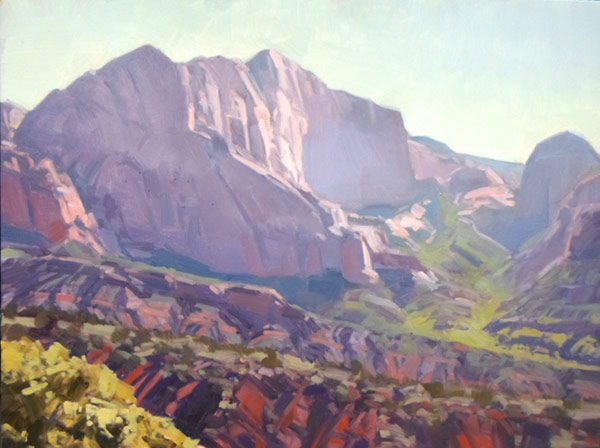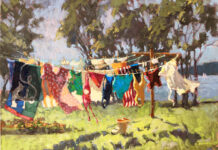In this series of articles, Utah artist J. Brad Holt talks about what artists are seeing as they look at the landscape. Holt studied geology in college and is attentive to what the rocks suggest in the scenes he paints.
Lead Image: “Kolob: Atmospheric Perspective,” by J. Brad Holt, 2013, oil, 12 x 16 in. Studio painting
At the beginning of the Cenozoic Era, 65 million years ago, the shapes of the continents and ocean basins were starting to be recognizable. The Atlantic Ocean had opened enough to separate North America from Europe, and South America from Africa. Africa was plowing north, closing the Tethys Sea to begin making contact with Europe. Likewise, India was making contact with southern Asia. The Alpine and Himalayan Orogenies were beginning. Australia and New Zealand had rifted away from Antarctica and were moving north. The Antarctic Peninsula and Cape Horn were still joined, causing the cold Antarctic currents to move north and mingle with warmer waters. This moderated temperatures and prevented the formation of large icecaps. In general, the earth was warmer all through the period of Pangaea, as the free flow of ocean currents acted to moderate world temperatures.
The demise of the dinosaurs at the close of the Mesozoic opened the way for the rise of the mammals. Mammals first evolved out of the therapsid reptile group during the Triassic Period. Throughout the remainder of the Mesozoic they remained small and shy, but their numbers grew, and their species diversified. When the higher niches opened up at the dawn of the Tertiary Period, mammals soon became dominant.
A couple of factors aided in this transformation. First was the general cooling trend throughout the era, caused by the rifting apart of the remnants of Gondwanaland. Second was the rise of the flowering plants, which evolved during the Cretaceous Period, and which rapidly began to change entire ecosystems. Two main groups of mammals arose: the marsupials and the placentals. The marsupial mammals evolved first, probably somewhere in the western part of Laurentia. They rapidly spread throughout the world, aided by the interconnectedness of Pangaea. The placental mammals represent an evolutionary advantage, and were able to replace the marsupials everywhere but Australia, which had rifted off far enough by this time to allow the marsupials to evolve in isolation.

The major mountain-building trends that have left their mark on the modern world got their start at the end of the Mesozoic, and continued through the Tertiary. In the Eastern Hemisphere the trend is east-to-west; in the Western Hemisphere, it is north-to-south. If one were to look at a globe, this would be evident. There is basically one long zone of east-west mountains stretching from France to China. On the western continents an even longer zone of orogeny stretches from the Transantarctic Mountains, up the spine of the Americas, all the way to Alaska. All of these mountains have formed since the Jurassic Period, with most of the mountain-building occurring in the last 50 million years. The youngest, sharpest, and highest of these ranges is the Himalayas, which were pushed up between 10 million and 20 million years ago, as the Indian subcontinent collided with the belly of Asia. The Asian plate overrode a significant portion of the Indian plate, raising the plateau of Tibet so that the continental crust is twice as thick in that region.
A similar event occurred in Europe. The boot of Italy is an accreted terrane delivered via the northern edge of the African plate. When this happened, 25 million years ago, it caused the uplift of the Alps. This also caused the closing of the western regions of the Tethys Sea, but subsequent down-warping of the southern edge of the European plate created the Mediterranean basin.
Other interesting tectonic events were happening in the Western Pacific during the Cenozoic. The islands of Japan, which began in the Paleozoic as a conventional volcanic island arc adjacent to a subduction zone off the east coast of Manchuria, had subsequently accreted to the Manchurian continental mass during the Mesozoic era. Around the beginning of the Tertiary, the motion of the Pacific plate changed to a northeasterly direction. This caused the terrane of Japan to tear off the continent, and opened the Sea of Japan. The islands of New Zealand tore away from Australia in a similar fashion at this same time period.
Australia itself began moving away from Antarctica during the Cretaceous Period. By 85 million years ago, when the early marsupial mammals were migrating around the world, the gap between Australia and Antarctica was still small enough to allow migration. This soon ended, before the migrations of placental mammals reached this far south and east. Meanwhile, New Zealand had separated enough that no mammals were able to reach her shore. Some of the higher ecological niches were filled there by flightless birds, as well as insects, some of which reached very large proportions. At the present day, the Australian/Indian plate is just beginning to collide with the Eurasian plate and the Philippine plate. Given enough time, new ranges of compressional mountains will arise in this region.

Throughout the Cenozoic Era, the world has grown colder as a result of the opening of seaways in the southern latitudes, and the blocking of equatorial currents in the tropics. In essence, there is less exchange of warm and cold waters, making the poles colder and the tropics hotter. This has resulted in widespread glaciation down into the temperate zones, several times in the last 2 million years. The last ice sheet began to retreat a mere 18,000 years ago. This is less than a heartbeat in geological terms.
We are presently in what might be termed an “Interglacial Warm Period.” If the future can be at all indicated in the record of the past, then it is very likely that the ice will return a number of times before the overall cool period is finished. At the time the last ice sheets were retreating, artists were creating stunning masterpieces on the walls and ceilings of Southern European caves.
We are creatures of this world. Its climate and geology affect us profoundly. We are witnesses to its fury, and stewards of its beauty. We tell its story, as we learn to avoid its wrath. The great game of natural selection has imbued us with intelligence, which is not only the greatest coping strategy that nature has ever devised, but a means of understanding and celebrating the process. Artists have been an integral part of this celebration since the beginning of our history. Heaven forbid that we should leave off now.




